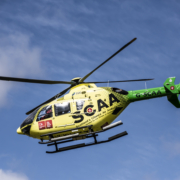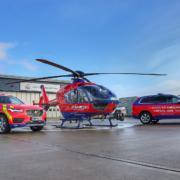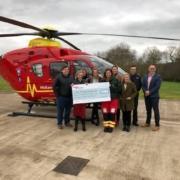East Anglian Air Ambulance’s UK first upgrade will provide greater comfort to patients
East Anglian Air Ambulance (EAAA) is the first air ambulance in the UK to upgrade its Airbus H145 helicopter with a new five blade rotor head. This UK-engineering first will generate more lift, reduce vibrations and improve handling and stability, providing improved comfort for EAAA’s patients and crew as they operate 24/7.
The Norwich-based Anglia One helicopter is the first aircraft of its type in the UK to be retrospectively upgraded to the brand-new state-of-the-art ‘D3’ specification. After several months in development this improvement to the aircraft, which includes increasing the number of rotor blades on the aircraft from four to five, will bring a number of significant benefits to patients who are treated by EAAA on a daily basis across East Anglia.
The new upgrade will reduce vibrations in flight, meaning more comfort for patients experiencing significant pain and will enhance patient safety through more stable monitoring during flight. The increase in lift will provide us with a greater weight allowance, resulting in EAAA being able to carry more fuel, equipment or another person such as a patient’s relative or significant other.
Dr Rob Major, Deputy Medical Director at EAAA said “Patients will benefit in a number of ways, due to the lower cabin vibrations, especially for those with very painful injuries, such as a fractured shin or femur. It will also make any air transfers safer for patients with traumatic injuries or major wounds which are actively clotting. In these cases, it’s important to keep the patient as still as possible so as not to disrupt that vital clotting process. The much smoother flight is likely to enhance our ability to capture more stable readings in the air, especially for anaesthetised patients.”
As a 24/7 operation, EAAA is always looking for ways to improve its service when bringing a mobile intensive care unit to the scene of an incident. The upgrade will be keenly noticeable at night when there are fewer airports open to refuel at, and carrying more fuel on board could result in an extra half an hour of flying time. The additional weight allowance means that more vital equipment can be carried on every mission, to bring advanced hospital-level care to where it’s needed; whether that’s somebody’s home or the roadside. In some cases, it will also mean that EAAA will be able to fly a guardian to hospital with a young child, giving even more support and comfort when it’s needed.
Matthew Jones, CEO of East Anglian Air Ambulance, said: “We are extremely proud to be the first air ambulance in the UK to fly this model of helicopter, helping us to maintain a leading and cutting-edge service for the people of East Anglia and the best possible care for the most seriously ill or injured. As a charity which doesn’t receive regular government funding, it’s really critical for us to have the support of specialist engineers at Babcock, our aviation partner, to keep us at the forefront of engineering advances to bring improvements such as this to our patients. This upgrade has been technically very challenging, taking several months to complete and we’re now looking forward to our Cambridge-based Anglia Two aircraft undergoing the same transformation, returning in a few months”.






